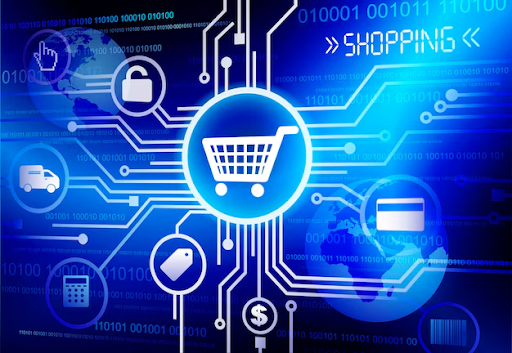The logistics industry is witnessing significant changes thanks to the development of technology and new market factors. In 2025, businesses will face numerous opportunities and challenges arising from emerging trends. This article will update the most important trends to help businesses optimize operations and seize opportunities in the logistics industry.
1. Enhancing the application of automation technology and AI

Artificial intelligence (AI) and machine learning (ML) will play a crucial role in shaping logistics trends in 2025 and beyond. These technologies enable proactive inventory and route management by helping to predict supply chain disruptions before they occur.
For example, IBM uses AI to enhance transparency in the supply chain, providing real-time analytics, predicting shipping delays, and flexibly adjusting routes accordingly.
Additionally, AI has significantly improved various operational aspects, including predictive forecasting and package classification, thereby enhancing the efficiency and adaptability of customer service.
2. Cross-border e-commerce

In 2025, cross-border e-commerce will increasingly focus on personalizing the customer experience. Logistics businesses will leverage big data to predict demand, provide customized shipping solutions, and create unique shopping experiences. In addition, the increase in diverse sales channels and global e-commerce platforms will create a more competitive market, requiring businesses to continuously innovate to attract and retain customers.
In addition, the increasing focus on sustainability issues will profoundly impact the logistics industry. Businesses will face greater pressure to reduce carbon emissions, optimize resource use, and ensure socially responsible business practices. This trend will drive the development of green logistics solutions, such as the use of biodegradable packaging, electric transportation vehicles, and sustainable supply chain management systems.
3. Green logistics: Focus on sustainability

With a focus on minimizing the environmental impact of logistics activities. The use of environmentally friendly transport vehicles, optimizing transportation routes, and minimizing waste will be key factors for the long-term sustainability of the logistics industry.
- Electric vehicles and clean energy vehicles: Many businesses are switching to using electric trucks and vehicles powered by renewable energy.
- Optimizing the supply chain: Solutions such as consolidated shipping help reduce the number of unnecessary trips.
- Recyclable packaging: Use environmentally friendly materials in product packaging.
4. Super-fast logistics (hyperautomation)

In the context of the booming e-commerce and the increasing demand for rapid delivery, the logistics industry is undergoing a true revolution. Hyperautomation in logistics is a concept that refers to the synchronized application of multiple advanced technologies, including artificial intelligence (AI), machine learning, robotic process automation (RPA), and data analytics tools, to maximize the automation of operational processes in the logistics industry.
As mentioned, hyperautomation is not just about automating a few individual processes, but rather about integrating multiple advanced technologies to create a comprehensive automation system.
- Goods-moving robots: The robots automatically move goods between shelves, helping to speed up order processing and minimize errors.
- Intelligent warehouse management system: Uses AI to track inventory, optimize storage space, and forecast demand.
- Smart route planning: AI helps plan the shortest delivery routes, saving fuel and time.
- Automating processes: Automating processes such as ordering, payment, and quality inspection.
- Delivery robots: Automated delivery robots help deliver goods quickly and conveniently, especially in urban areas.
5. The rise of self-driving car technology

An important trend in 2025 is the rise of self-driving cars. Companies like Tesla and Volvo are leading the way in deploying AVs to simplify transportation and minimize human error.
Take Volvo's recent pilot, which shows fully automated trucks from loading to delivery, demonstrating the efficiency and cost-saving potential of electric vehicles.
6. Investing in 5G and IoT technology

The year 2025 promises to be a breakthrough year for 5G technology and the Internet of Things (IoT) in the logistics industry. With ultra-fast data transmission speeds and extremely low latency, 5G will facilitate the connection and control of millions of IoT devices in the supply chain. This opens up endless opportunities to optimize the shipping process, enhance cargo tracking capabilities, and improve customer experience. From automated smart warehouses to unmanned transport vehicles, the application of 5G and IoT will help logistics businesses reduce costs, increase operational efficiency, and gain a competitive edge in the global market.
DHL is a typical example. It integrates IoT into warehouse solutions, where connected sensors and devices can continuously monitor inventory levels and environmental conditions, ensuring optimal inventory levels and product quality, significantly improving operational reliability.
7. Enhance data security in logistics

With the increasing reliance on digital technology, ensuring data security in logistics operations has become crucial. Advanced encryption technology and secure cloud services are crucial for protecting sensitive information from cyber threats.
Companies like Cisco are providing suitable cybersecurity solutions for the logistics industry, ensuring data integrity and security throughout the entire supply chain.
8. The transparency and efficiency of Blockchain

Blockchain technology is changing logistics by increasing transparency and efficiency.
Walmart has successfully implemented blockchain to track food sources, significantly reducing the time required to trace food sources from several weeks to just a few seconds. This enhances security and trust, streamlines the recall process, and saves costs while protecting the brand's reputation.
As we enter 2025, these innovative logistics solutions highlight how technology continues to reshape the logistics landscape. By adopting these technologies, businesses can increase efficiency, reduce costs, and enhance customer satisfaction. Understanding the latest logistics trends and future logistics technologies is crucial for maintaining a competitive edge in a dynamic market environment.
9. Conclusion
The logistics industry in 2025 is undergoing a strong transformation with the emergence of new technologies. Automation, artificial intelligence, and green supply chains will reshape the entire industry. Businesses need to seize this opportunity to enhance operational efficiency, reduce costs, and better meet customer demands. The future of the logistics industry is extremely bright, opening up many development opportunities for businesses that know how to seize the moment.